
|

|
Health, Grooming, and Medicine in the Viking Age
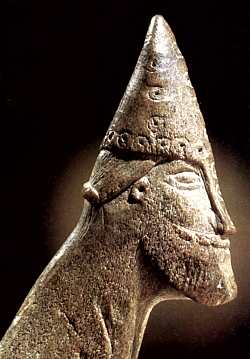 |
Personal appearance. People kept a neat appearance during the Viking age. One of the few naturalistic renderings of the human face from the Viking age is the antler carving shown to the left. The figure depicts a man wearing a helmet, with his hair neat and trim. On his face, he wears a beard and a long moustache. In chapter 3 of Vatnsdćla saga, Jökull is described as a large man with fair, shoulder-length hair. People thought him handsome. Literary evidence suggests that women wore their hair long. When Hallgerđur met Gunnar in chapter 33 of Brennu-Njáls saga, she is said to have thick, fair hair that came down to her breasts. In addition, the medieval lawbook Grágás (K254) prohibited women from wearing their hair short, one of several masculine traits that was specifically forbidden by the laws. We know little about the details of face and body features, but it is safe to say that Scandinavians in the Viking age had features that closely resembled modern Scandinavians today. The average height of men in Norway in the Viking era, based on skeletal measurements, was 176cm (5ft 9in), with a range from 170-181cm (5ft 7in to 5ft 11in), which was taller than other Europeans during this time. The average height of women was 160cm (5ft 3in), with a range from 149-164cm (4ft 11in to 5ft 5in). |
Ibn Fadlan, an Arab who met Viking traders in Russia in the year 921, commented that the men were tall like palm trees. He also noted that "Each man, from the tip of his toes to his neck, is covered in dark-green lines, pictures, and such like." To many people, this description suggests that Vikings wore tattoos. I remain unconvinced.
The word used in the original is obscure and is more commonly used to describe the decorations inside of mosques. Additionally, Ibn Fadlan described many other aspect of the Rus traders that are not supported by other sources. That these descriptions of body decorations do not show up in other early medieval Scandinavian sources, and that they seem not to have been used by other Viking-age northern Europeans makes me think it unlikely that Viking people commonly wore tattoos.
|
One form of body decoration that is better supported is modifications to the teeth. The photo shows crescent-shaped grooves cut into the incisors. Hundreds of Viking-age skeletal remains have been found in various locations with horizontal grooves carefully filed into the front surfaces of the most visible teeth. Almost all of these have been found in eastern Sweden, but others were found in Denmark and England. It's been suggested that these grooves were filled with a pigment or dye to color them. It's been further suggested that the Danish king Haraldr blátönn (Harald Bluetooth) received his name not from teeth darkened from decay, but rather from intentional modifications and colors applied to his teeth. |
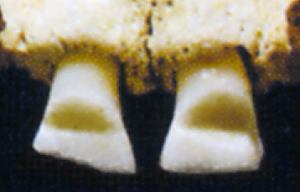 |
It is likely that all men had facial hair. The stories say that men who were unable to grow a beard were mocked. For example, Brennu-Njáls saga tells the story of Njáll Ţorgeirsson, who was beardless. Chapter 20 says that he was married, with six children, and that he was wealthy and handsome, but that he had a peculiarity: he could not grow a beard. In chapter 44, Hallgerđr asked some gossiping beggarwomen what was going on at Njál's farm at Bergţórshváll. The women said that Njál's sons were preparing for battle, and his farmhands were spreading manure on the hayfield to fertilize it. Hallgerđr wondered why they didn't spread it on Njál's chin, so his beard would grow. She gave Njáll the name "Old Beardless", and his sons "Little-Dungbeards". Sigmundr composed scandalous poetry using the new names.
Njál's son, Skarpheđinn, repaid Sigmundr for the verses by driving his axe through Sigmund's shoulder, forcing him to his knees, and then by splitting Sigmund's head with his next blow.
Hair washing and cutting was a function performed by women for men and seems to have usually been performed outdoors. In chapter 18 of Víglundar saga, Víglundur asked Ketilríđur to cut and wash his hair before he left for Norway. After the job was done, he promised her to permit no one else to cut and wash his hair as long as she was alive.
In chapter 21 of Heiðarvíga saga, Barði stopped to collect Odd to ride to the heath where the revenge killings were to take place. Barði found that Odd's wife was washing his hair. Odd's horse was saddled, and his weapons were prepared. But the final preparation for the trip was a cleansing. Barði asked Odd's wife to finish the job properly before their departure.
The medieval Icelandic lawbook Grágás (St 361) calls for the most severe penalties for a man who makes someone dirty in order to disgrace him. Similarly, pushing a man into water or urine or food or dirt resulted in the same penalties, whatever the reason.
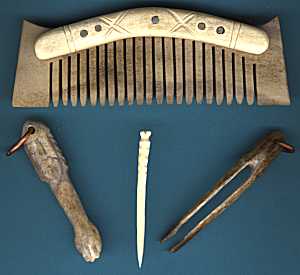 |
A variety of grooming aids are common archaeological finds in virtually every occupied site. They're so common that one has to conclude that they were in wide use, and they are found in both male and female graves. Shown to the left are modern reproductions of a comb (top), and from left to right below, an ear wax scraper, a toothpick, and a pair of tweezers. These reproduction items are made from bone or antler, although some luxury items from the Norse era were made from ivory. In addition, a variety of wash basins have been found at archaeological sites. A historical comb from the 9th century is shown in the sketch to the right and another in the photo below. Like most of the historical combs, they have much finer teeth than the reproduction shown to the left. It has been suggested that comb-making was a specialized activity in the Viking age performed by skilled craftsmen, rather than at home by individual farmers.
|
 |
Grooming. Evidence from both literary sources and archaeological sources
shows that cleanliness, good hygiene, and regular grooming were a part of Norse
life. The Norse poetic literature emphasizes the need for cleanliness and regular
grooming. Here are two examples:
From Reginsmál (25):
Kemđr ok ţveginn skal kśnna hverr | Combed and washed every thoughtful man should be
ok at morni mettr; | and fed in the morning;
ţvíat ósýnt er, hvarat apni křmr; | for one cannot foresee where one will be by evening;
illt er fyr heill at hrapa. | it is bad to rush headlong before one's fate.
From Hávamál (61):
Ţveginn ok mettr ríđi mađr ţingi at, | Washed and fed, a man should ride to the Assembly
ţótt hann séđ vćddr til vel; | though he may not be very well dressed;
skúa ok bróka skammiz engi mađr, | of his shoes and breeches no man should be ashamed
né hestz in heldr, ţótt hann hafit góđan. | nor of his horse, though he doesn't have a good one.
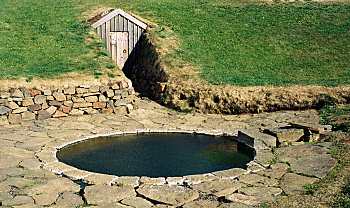 |
Besides the comments in the poems and stories, there is other evidence that the Norse were regular bathers. Hot spring baths built in the Norse era still exist in modern Iceland. The photo to the left shows the bath built by Snorri Sturluson at his farm at Reykholt, around the year 1210. It's fed by water piped from separate hot and cold water springs, so the temperature can be adjusted to suit. The door in the hillside behind the bath leads to a tunnel which probably led back to Snorri's farmhouse. |
|
The sketch shows the appearance of Snorralaug (Snorri's bath) as it looked in the 19th century. The farm of Reykholt is on the hill above the bath. The bath is about 4 meters in diameter (13 feet), with stone steps leading down into the pool. There are bench seats around the periphery below the water for comfortable lounging. |
 |
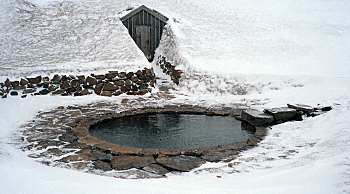 |
Even in winter, the bath at Reykholt was probably very inviting, warm and relaxing. Snorri apparently spent many hours in the bath daily. |
|
I would, too, with a view as splendid as this. Other than the modern buildings, the vista in Snorri's time was probably similar. |
 |
Not surprisingly, hot springs baths drew bathers from a wide area. Shelters built at the bath served not only bathers, but also women who were washing clothes in the hot water. Bathing in the hot springs was also a social activity. While Kjartan was wooing Guđrún, he timed his visits to the hot springs bath to coincide with hers, as described in chapter 39 of Laxdćla saga.
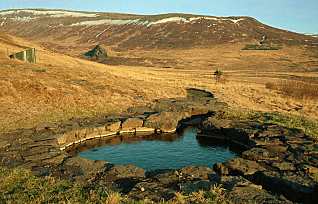 |
Until recently, Kjartan and Guđrún wouldn't recognize the bath at Laugar; the hot water is collected and piped to the nearby school and community center (right). However, in the fall of 2009, a new stone-lined bath was built (left), which might more closely resemble the bath enjoyed by Kjartan and Guđrún. |
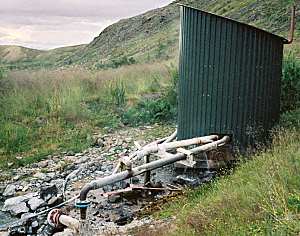 |
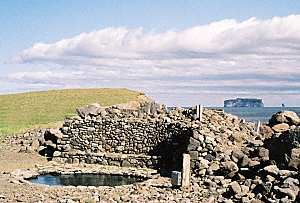 |
The reconstructed hot bath Grettislaug is shown to the left. After Grettir swam from his island hideaway Drangey across the cold waters of Skagafjörđur, his first stop was at the hot bath to warm up, as described in chapter 75 of Grettis saga. |
|
The bath is regularly used by Icelanders and visitors, even if they didn't just swim from Drangey. I can attest that it's a wonderful place to spend a blissful hour soaking in the hot water. |
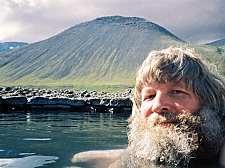 |
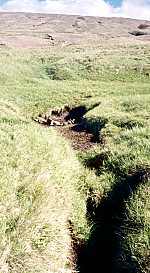 |
Not all baths were as nicely turned out as Grettislaug. The hot spring bath at Heydalur in Mjóifjörđur is shown to the right. A depression in the ground collects the water from the hot spring. Despite the simple setup, it is a relaxing place to soak. The photo to the left shows the hot springs on the hillside at Laugarhús in Hrafnkelsdalur. When turf is added to the dam in the foreground, warm water collects in the muddy depression around the source of the hot spring in the background. Today, the water is collected and used for drinking water for the sheep at Laugarhús. |
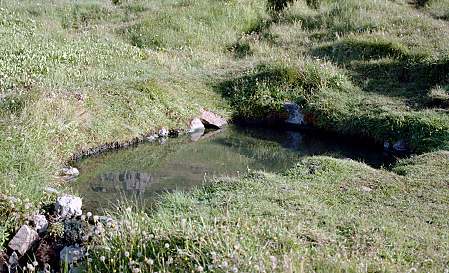 |
Another form of Icelandic bathhouse is described in chapter 28 of Eyrbyggja saga. It was an outbuilding, dug into the ground. It had a window set above a stone oven so that water could be thrown onto the oven from the outside, making the bathhouse very hot.
Some longhouses had rooms which are thought to have been used as sweatrooms, an early precursor to the modern Swedish sauna.
The Anglo-Saxon defenders of England realized that the Norse invaders took regular baths, and were known to delay their attack until Norse bath time, when the Norseman had shed their clothes (and their weapons).
John of Wallingford, the abbot of St. Albans Abbey wrote in his chronicles that the Norse invaders in England were far more attractive to Anglo-Saxon women since, unlike Anglo-Saxon men, they combed their hair daily, took baths weekly, and laundered their clothing regularly.
A treaty negotiated in the year 907 between the Byzantine Empire and the Rus (the Norse people from Sweden and the east Baltic area who traded with Byzantium) contained most of the usual provisions one might expect: the Byzantium empire was obliged to give the Rus traders food, drink, and supplies for their ships. However, an unusual condition in the treaty was that Byzantium was required to provide baths for the Rus "as often as they want them".
| At Alţing, people bathed in the Öxará river, below the bridge. In
the time of the sagas, the bridge was probably situated about where the
modern church is located (the left-most building in the photo). The
bathing area was probably to the right of the modern farm house, where
the river widens as it approaches the adjacent lake. In chapter 8 of Hrafnkels saga, Sámr and Ţorbjörn bathed in the river early one morning. While washing, they saw Ţorkell for the first time, who later agreed to help them in their dispute with Hrafnkell. |
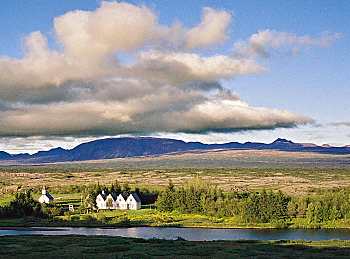 |
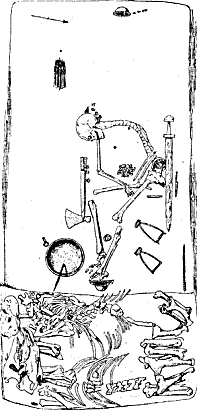 |
Health. Studies of burial remains from the Viking age suggest that good health and long life were possible for at least some of the population. For example, a recent study of 11th and 12th century skeletal remains from Skeljastađir in Iceland showed that the population was generally healthy. But that is not to say that life was free of disease and pestilence. The Skeljastađir remains also suggest that oral health was generally good. Compared to modern western diets, the Viking-age diet had more coarse food, fewer refined foods, and much less sugar. Accordingly, the Viking-age teeth show considerable wear, but few instances of dental caries or decay. |
|
A more serious dental problem was calculus, the build-up of hardened plaque on the teeth, which today, we treat with regular cleaning. The buildup can result in infections of the gums and jaw, resulting in the loss of teeth. The photo shows the skulls of a man (left) and woman (right) who died at the end of the 10th century. Both are well into their adult years. The man kept virtually all of his teeth until the end of his life, but the woman had a long-term infection that resulted in the loss of virtually all her teeth. Skeletal studies like this also inform us about Viking society. This woman lived for many years without teeth and would have needed special food prepared for her at every meal. That someone in the family was willing and able to do this task suggests that Viking-age people cared for the sick and infirm. |
Similarly, skeletal remains of elderly people show fractures that have
healed, implying that elderly people were cared for.
 |
In trading towns, where dense population made adequate sanitation difficult, many people probably routinely suffered from ill-health. The sediment off-shore from the trading town at Birka contains eggs of human parasites. The mature parasites would have caused nausea, diarrhea, and other illnesses among the residents of the town.
Good health was seen as an extension of good luck. So preventative medicine consisted primarily of chants and charms that would maintain one’s good fortune. The eddaic poetry is full of charms for the maintenance of health in daily life, such as those in Hávamál.
Runic inscriptions were used as magic to maintain health. Chapters 73 and 77 of Egils saga Skalla-grímssonar tell how a young woman's health was first ruined through the use of improper runes, and then restored by correct runes. The runes were carved on a whalebone placed under the woman's bed.
Medicine. In addition to magical arts, the medical arts were also practiced in the Norse era. Classical herbal remedies appear to have been known, along with local herbs specific to the Norse region. Medical treatments consisted of: lancing; cleaning wounds; anointing; bandaging; setting broken bones; the preparation of herbal remedies; and midwifery. The 13th century Icelandic law book Grágás says that one must hold harmless a person who bleeds or cauterizes someone for the good of their health [St364], suggesting those techniques were also known and used.
Studies of skeletal remains from the Viking age show evidence of fractures that have healed in ribs, and bones of the arms and legs. The stories also provide evidence of broken limbs that were manipulated to allow the bones to knit more satisfactorily. In chapter 10 of Gunnlaugs saga ormstungu, Gunnlaug's ankle was twisted out of joint in a wrestling match. Later, his foot was bandaged and the joint re-set. (Ţá var vafiđur fóturinn og í liđinn fćrđur.) In Íslendinga saga (which takes place after the Viking age, in 12th century Iceland), it is said that Loptr broke his leg one summer (chapter 40). When it was set, Loptr thought it too weak to stand on. He had the leg broken a second time and instructed how it should be set. When the leg knit a second time, Loptr was not very lame. In chapter 45 of Eyrbyggja saga, Ţóroddr was wounded in the neck. As the wound healed, his head drooped to one side. He asked Snorri gođi to reopen the wound and reset his head straighter.
In the early part of the Norse era, most of the population had to rely on themselves or on local people with special abilities. Educated medical specialists were rare. Chapter 6 of Eiríks saga rauđa tells of an protracted period of disease at Lysufjorđur in Greenland. The sick lay in bed in the hall, while the healthy helped them prepare for death.
An inured person sought a healer (lćknir) for medical assistance. In chapter 6 of Ţórđar saga hređu, Indriđi suffered gaping wounds during a battle. When asked if he might pull through, he said, "I think there is some hope of it, if a healer sees me."
|
Later in the Norse era, it appears that certain men chose the practice of medicine as their livelihood. In chapter 28 of Magnúss saga ins góđa, King Magnús the Good chose twelve men to bandage men’s wounds after the battle on Lyrskov Moor in 1043. These men subsequently acquired reputations as medical men. From these men, several notable families of physicians descended, including the Icelander Hrafn Sveinbjarnarson (died 1213), who was highly regarded for his healing skills. A memorial stone is located on his farm at Hrafnseyri (right). |
 |
Archaeological evidence from grave sites shows that surgery was performed from time to time, some of which was successful (i.e., the patient lived for a time after the procedure). In addition, some of the late literature (e.g., Biskupa sogur) suggests that surgery was occasionally performed.
In more densely settled areas, such as trading towns, epidemics must have been occasional occurrences. Smallpox, dysentery, and leprosy are recorded in the literature. The Norse must have faced these with resignation, since little could be done to control them. The attitude towards the sick is reflected in an incident from chapter 28 of Ljósvetninga saga. Már booked a passage from Iceland to Norway on a ship. While the captain waited for favorable winds, a boat drew up to the ship and asked if Már was aboard. The boat carried Már's kinsman, Ţorvaldur the leper, and the men in the boat insisted that Már take his sick kinsman with him. Már took Ţorvaldur back to shore and returned to the ship without him, telling the crew he had made arrangements. Later, it was discovered Már had murdered his kinsman to avoid having to deal with him.
A mass grave at the winter camp of the Viking Great Army in Repton (England) suggests that the people buried there succumbed to an epidemic of some sort. Of the several hundred individuals buried there, most were adult males with no indications that they died of battle injuries. The Viking invaders wintered over in this camp during the winter of 873-874.
Skeletal remains show that at least some people lived to old age in the Viking era, but they also show that degenerative joint disease was common in old age. The stories tell of other conditions due to old age, such as blindness and deafness. Egils saga (chapter 85) says that when Egill was an old man, he grew frail, with stiff legs, and that both his vision and hearing failed. His skill in composing poetry seems to have been unimpaired, based on the poetry he composed mocking his infirmities in old age. He was more than 80 years old then.
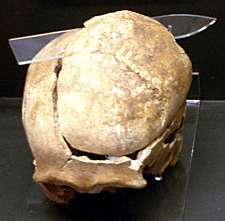 |
Battle Injuries and First Aid. Both the saga literature and forensic studies of skeletal remains suggest that battle injuries could be horrific. The skull shown to the left is from a man who died of battle injuries in the 11th century. The top of the skull was removed by a blow from a sword. The terminus of the blow is indicated in the photo by the clear blade. The femur (leg bone) shown to the right is from another man who died of battle injuries in the 11th century. The bone shows clear marks of the impact of ring mail against the bone, suggesting his upper leg was hit with a sword blow so powerful as to force the rings of his mail shirt through the muscles of his leg into contact with the bone. Astonishingly, this injury was not the cause of his death. His skeletal remains show other serious injuries received in that battle. However, it was a cut that partially severed his spine at the neck that killed him. |
 |
Yet, there remains a disconnect between the many fights described in the medieval literature and the paucity of human skeletal remains found that show battle injuries, not only in Iceland, but throughout the Viking lands. There are hundreds of individual fights described in the Sagas of Icelanders, but the human skeletal remains found in Iceland that show trauma due to weapons number in the single digits. Why the discrepancy? Perhaps the sagas exaggerate the frequency of fights. More likely, skeletal remains of only a tiny percentage of the population alive in Iceland during the Viking age have been excavated and studied. Perhaps the remains of the saga warriors have not yet been found.
The sagas tell of several types of first aid used during a fight. Shields were thrown over fallen men to protect them from further injury (Brennu-Njáls saga chapter 150). During Gísli's last battle (Gísla saga Súrssonar chapter 36), Eyjólf's men thrust at Gísli with spears until his guts fell out. Gísli bound his guts up in his shirt with a cord and continued fighting. When fights continued for a long time (for example Heiđarvíga saga chapter 31), a pause was called in the fighting to allow men to bind up their wounds.
|
An example of battlefield medicine is described in chapter 234 of Óláfs saga helga. Ţormóđr was wounded by an arrow in his side. He broke off the shaft and supported his companions in the fight as best he could. After the battle had been lost, he left the field and entered the hut where the healer women were tending the wounded. One of the women inspected the wound and could see the iron arrow head, but could not determine its path to determine what internal organs it had struck. She gave Ţormóđr a hot broth, containing leeks and onions and other herbs. If, after eating it, she could smell the broth from his wound, she would know that vital parts had been injured, and that the wound was fatal. Ţormóđr refused the broth. Instead, he directed the woman to cut into the wound to expose the iron arrow head. He grabbed hold of the arrow head with pincers and pulled it out. Seeing fatty fibers on the arrow head, Ţormóđr said, "See how well the king keeps his men. There is fat by my heart," and he died. |
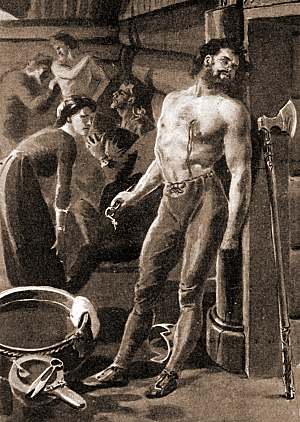 |
Blood from a wound was examined to determine the extent of the injuries. In chapter 45 of Eyrbyggja saga, Snorri gođi examined the snow where Bergţór had lain after being injured in battle. Snorri picked up the bloody snow, squeezed it, and put it in his mouth. Realizing that it was blood from an internal wound, Snorri said that Bergţór was a dead man and there was no need to chase after him.
Saga evidence suggests that some men who suffered serious wounds continued to fight and were praised for their courage. In chapter 30 of Heiđarvíga saga, Ţóroddur cut off Ţorbjörn's foot at the ankle. Ţorbjörn continued to fight, killing Ţóroddur, then turning to fight Barđi.
Both the saga literature and forensic studies of skeletal remains show that people survived serious battle injuries and lived to fight again after their wounds healed. In chapter 23 of Víga-Glúms saga, Ţórarinn was struck by a blow that cut through his shoulder such that his lungs fell out. He was bound up, and Halldóra watched over him until the battle was over. Ţórarinn was carried home where his wounds were treated, and over the summer, he recovered.
The brothers Víglundur and Trausti were severely wounded in a fight described in chapter 16 of Víglundar saga. Their father helped them home and Ólof bound their wounds. It took them twelve months to recover their health.
Some skeletal remains show both unhealed battle injuries and healed battle injuries in the same skeleton, confirming the stories in the sagas. The injuries suggest that the man suffered a wound, recovered, and then fought again later in his life.
Magic was used to heal the injuries received in a duel, as described in chapter 22 of Kormáks saga. Ţórdís advised Ţorvarđr to speed his recovery by reddening a nearby hill with the blood of the sacrificial bull killed by Kormákr after the duel, and by making a feast out of the meat from the bull for the elves living in the hill.
Magic was used to prevent a wound from healing, as well. In chapter 57 of Laxdćla saga, Eiđur says that a wound inflicted by his sword Sköfnung would not heal unless rubbed with the sword's healing stone (lyfsteinn).
|
|
©1999-2025 William R. Short |